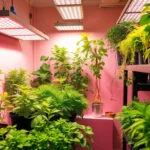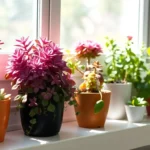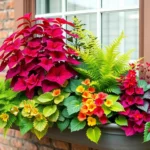We all love filling our homes with beautiful greenery but as cat parents we face a constant dilemma: which plants won’t harm our curious feline friends? Many popular houseplants are surprisingly toxic to cats and can cause serious health issues if nibbled or ingested. The good news is you don’t have to choose between a plant-filled home and your pet’s safety.
Creating a cat-friendly indoor garden is absolutely possible with the right plant choices. We’ve discovered dozens of stunning non-toxic plants that’ll transform your space while keeping your whiskered companions completely safe. From air-purifying options to low-maintenance varieties these pet-safe plants offer all the beauty and benefits you’re looking for.
Whether you’re a seasoned plant parent or just starting your indoor jungle journey we’ll guide you through the best cat-safe options that thrive indoors. Your home can be both lush and safe – and we’re here to show you exactly how to make it happen.
Spider Plant: The Perfect Low-Maintenance Cat-Safe Option
Spider plants stand out as one of our top recommendations for cat owners seeking beautiful houseplants without safety concerns. These resilient green companions offer the ideal combination of visual appeal and pet-friendly properties.
Easy Care Requirements and Watering Schedule
Watering spider plants requires minimal effort since they thrive with weekly watering sessions during growing season. We recommend checking soil moisture by inserting your finger one inch deep into the potting mix. Allow the top layer to dry completely between waterings to prevent root rot and maintain optimal plant health.
Light requirements remain flexible as spider plants adapt well to bright indirect sunlight or partial shade conditions. Place them near east or north-facing windows for consistent growth without leaf scorching. Temperature preferences range between 65-75°F making them perfect for typical indoor environments.
Fertilizing becomes necessary only during spring and summer months using diluted liquid fertilizer every 4-6 weeks. Repotting occurs every 2-3 years when roots become crowded in their current container.
Air Purifying Benefits for Your Home
NASA’s Clean Air Study identifies spider plants as effective air purifiers that remove formaldehyde and xylene from indoor environments. We’ve observed these plants continuously filtering toxins while producing fresh oxygen throughout the day and night cycles.
Formaldehyde removal happens naturally through the plant’s leaf surfaces and root systems. Xylene elimination occurs simultaneously helping reduce common household chemical pollutants from cleaning products and furniture.
Humidity levels increase around spider plants as they release moisture through transpiration creating more comfortable living spaces. Air circulation improves in rooms containing multiple spider plants improving overall indoor air quality for both humans and cats.
Why Cats Love to Nibble on Spider Plant Leaves
Texture appeals to cats since spider plant leaves provide satisfying chewing experiences similar to grass blades. We notice cats gravitate toward the long slender foliage that moves gently with air currents triggering their hunting instincts.
Safety remains guaranteed when cats consume spider plant leaves as they contain no toxic compounds. Digestive benefits may occur since many cats use plant material to aid stomach upset or hairball elimination naturally.
Behavioral enrichment happens when cats interact with spider plants through gentle batting at dangling plantlets or “babies.” Placement strategies include hanging baskets or tall plant stands to control access while still allowing occasional safe nibbling sessions.
Boston Fern: A Lush Green Addition to Cat Households
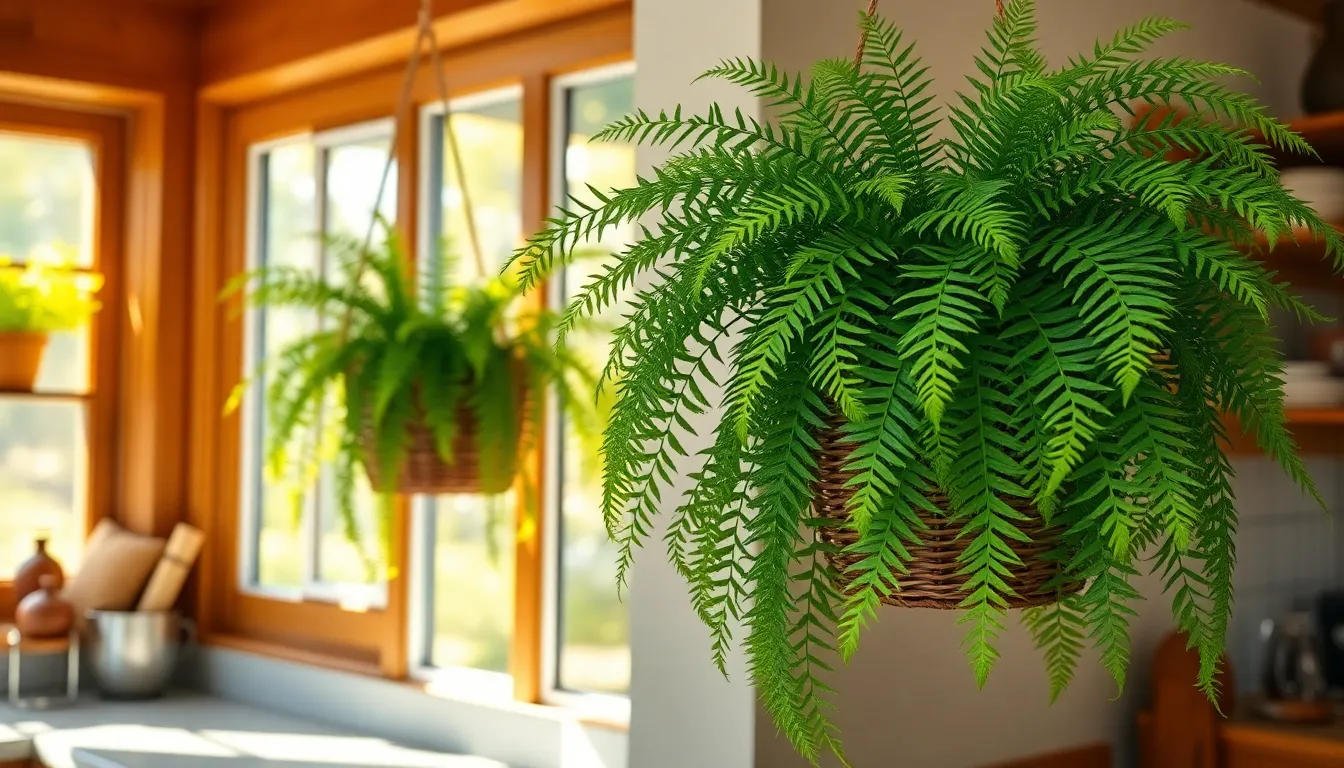
Boston Fern stands out as another excellent choice for cat owners seeking lush greenery without safety concerns. This non-toxic plant brings natural beauty to your home while keeping your feline friends completely safe.
Humidity Requirements and Placement Tips
Boston Ferns thrive in high humidity conditions that mimic their natural forest floor habitat. We recommend placing them in bathrooms or kitchens where moisture levels naturally stay elevated.
Indirect light works best for these plants since direct sunlight can scorch their delicate fronds. Consistent soil moisture helps maintain their vibrant green appearance throughout the year.
Misting your Boston Fern occasionally creates the humid environment it craves. Positioning the plant near a humidifier also provides the steady moisture these plants need to flourish indoors.
Non-Toxic Properties That Keep Cats Safe
According to the ASPCA, Boston Ferns pose no poisoning risk to cats who might chew on their leaves. This safety rating makes them a worry-free addition to homes with curious cats who explore plants through nibbling.
Pet safety sources confirm that these plants contain no harmful compounds that could affect your cat’s health. Even if your feline companion decides to sample the fronds, you can rest assured knowing they’re completely safe.
Cat owners can confidently display Boston Ferns throughout their homes without monitoring their pets’ interactions with the plant. This peace of mind allows you to enjoy beautiful greenery while maintaining your cat’s wellbeing.
Decorative Appeal in Hanging Baskets
Boston Ferns showcase stunning visual appeal with their cascading, feathery fronds that create an elegant focal point. Their arching growth pattern makes them perfect candidates for hanging baskets or elevated shelves.
These plants complement various interior design styles while adding lush texture to any room. Hanging placement also keeps the trailing fronds out of reach if you prefer your cats not interact with the plant at all.
Elevated positioning allows the Boston Fern’s graceful fronds to cascade naturally while serving as a verdant centerpiece. This decorative flexibility lets you incorporate safe greenery into your home’s aesthetic without compromising your cat’s safety.
Ponytail Palm: A Unique Statement Plant for Pet Owners
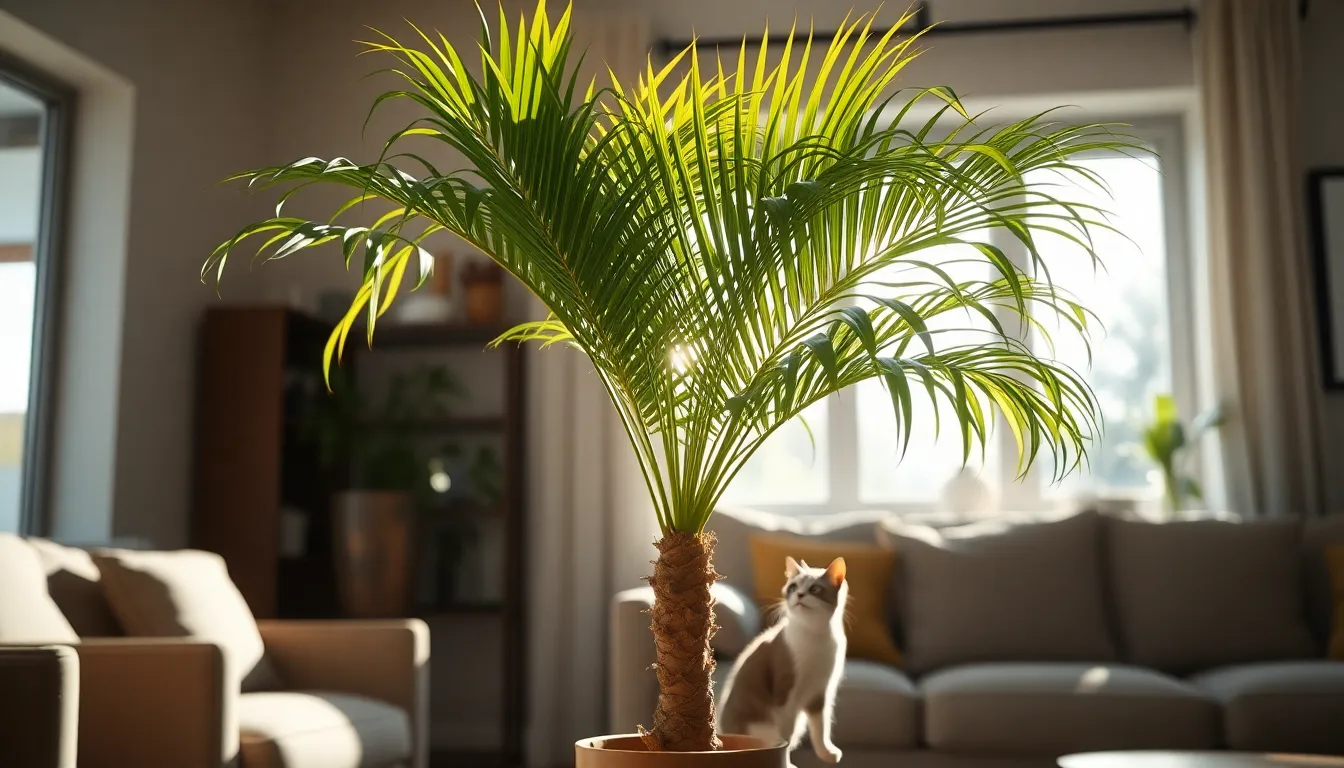
The Ponytail Palm brings architectural elegance to your home while keeping your feline friends completely safe. We recommend this stunning plant for cat owners who want a low maintenance statement piece that won’t harm curious pets.
Drought-Tolerant Care Instructions
Watering your Ponytail Palm requires patience since its bulbous trunk stores water efficiently. Allow the soil to dry completely between waterings, typically waiting 1-2 weeks depending on your home’s humidity levels. Bright, indirect light keeps this plant thriving without the stress of direct sun exposure.
Well-draining soil prevents the root rot that can kill these otherwise resilient plants. Overwatering poses the biggest threat to Ponytail Palms, so we suggest checking soil moisture with your finger before adding water. Indoor temperatures between 65-75°F create ideal growing conditions year round.
Safe Interaction with Curious Cats
Non-toxic properties make the Ponytail Palm worry-free for homes with cats who explore plants. Your feline companions can safely investigate or even nibble these plants without experiencing poisoning symptoms. Tough, coarse leaves naturally discourage most cats from excessive chewing due to their unappealing texture.
Pet owners appreciate this plant’s safety profile compared to many popular houseplants that pose serious health risks. We’ve observed that cats typically lose interest in Ponytail Palm leaves after initial exploration. Emergency vet visits become unnecessary when cats interact with these completely safe plants.
Distinctive Appearance and Growth Patterns
Growing slowly to heights of 8 feet indoors, Ponytail Palms develop their signature swollen base over time. Long, curly leaves cascade from the bulbous trunk, creating the distinctive “ponytail” appearance that gives this plant its common name. Modern interior designs benefit from the architectural lines and sculptural form these plants provide.
Years pass before important size changes occur, making these plants perfect for consistent home decor planning. Compact growth patterns suit apartment living while still delivering visual impact in larger spaces. Indoor specimens maintain their striking proportions better than their outdoor counterparts, which can become quite massive.
Parlor Palm: Elegant Tropical Vibes Without the Worry
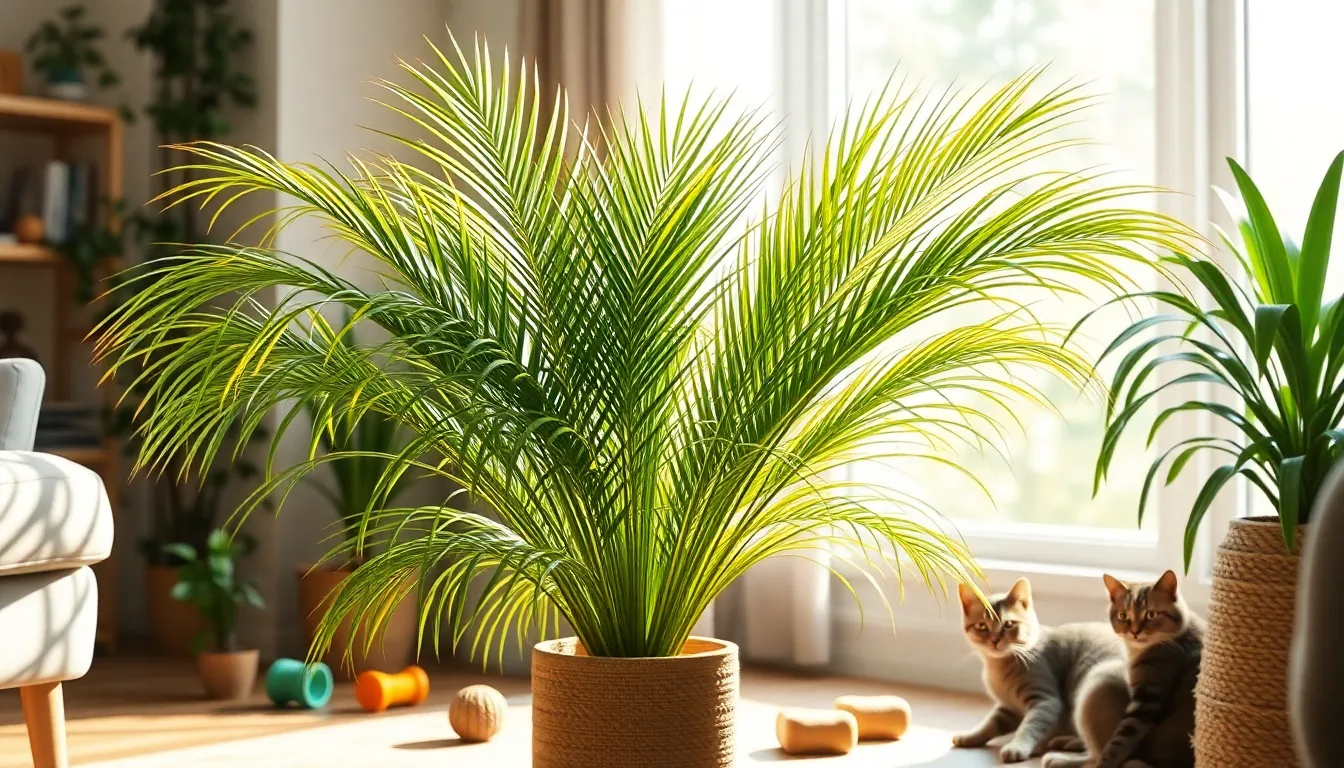
We’ve discovered another exceptional choice that brings sophisticated tropical beauty to cat-friendly homes. The Parlor Palm (Chamaedorea elegans) delivers elegant indoor aesthetics while maintaining complete safety for our feline companions.
Light and Water Requirements for Healthy Growth
Parlor Palm thrives in low to moderate indirect light conditions, making it remarkably adaptable to most indoor environments without requiring direct sunlight exposure. We find this flexibility particularly valuable since it allows placement in various rooms throughout our homes without worrying about lighting constraints.
Watering requirements remain straightforward and forgiving for busy pet owners. The plant prefers consistently moist soil but shouldn’t be waterlogged, so we recommend allowing the top inch of soil to dry out between waterings to support healthy root development. Indoor temperatures and moderate humidity levels that we typically maintain in our homes create ideal growing conditions for this resilient palm.
Cat-Safe Benefits and Peace of Mind
Safety stands as the Parlor Palm’s most important feature for cat owners. This plant contains no toxic compounds that could harm our cats, providing complete peace of mind when curious felines investigate or nibble on its fronds. Even if our cats decide to sample the leaves, they’ll remain completely unharmed.
We appreciate how this non-toxic nature eliminates the stress of constantly monitoring our pets around houseplants. Unlike many popular indoor plants that pose serious health risks to cats, the Parlor Palm allows us to enjoy beautiful greenery without compromising our pets’ wellbeing or requiring vigilant supervision.
Adding Height and Texture to Indoor Spaces
Beyond its safety credentials, the Parlor Palm contributes sophisticated visual appeal to interior design schemes. Its slender green fronds create elegant height and delicate texture that enriches room aesthetics without overwhelming smaller spaces. We find this plant particularly effective at adding tropical charm to modern and traditional decor styles alike.
The palm’s graceful growth pattern makes it versatile for various placement options throughout our homes. Whether positioned as a floor plant in living areas or displayed on plant stands, its distinctive fronds provide ever-changing visual interest that enhances the overall ambiance of cat-friendly indoor gardens.
Peperomia: Compact Beauty That’s Completely Cat-Friendly
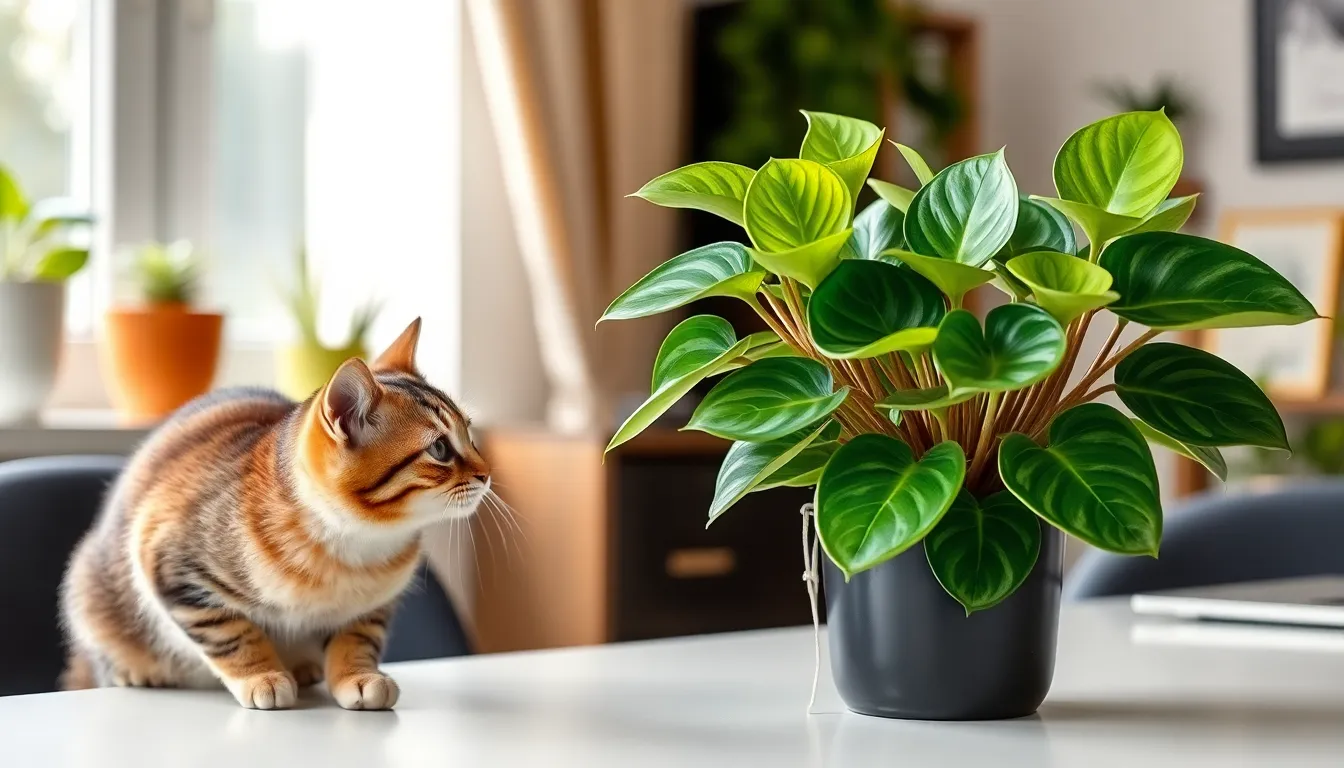
Peperomia plants offer cat owners an ideal combination of visual appeal and complete safety for their feline companions. These charming houseplants provide pet-friendly greenery that requires minimal maintenance while adding distinctive character to any indoor space.
Variety of Species and Leaf Patterns
Diverse Peperomia species showcase an impressive range of leaf textures and patterns that’ll complement any home decor. Smooth-leafed varieties like Peperomia obtusifolia create sleek, modern appearances with their glossy green surfaces. Wrinkled species such as Peperomia caperata add textural interest with their deeply ridged foliage that catches light beautifully.
Variegated options bring striking color combinations to your cat-safe plant collection. Green and cream striped varieties brighten darker corners while maintaining their pet-friendly status. Color variations span from deep emerald greens to silvery patterns that create visual depth without compromising your cat’s safety.
Each species maintains its non-toxic properties while offering unique aesthetic qualities. This diversity allows you to select plants that perfectly match your interior design preferences while ensuring complete feline safety.
Simple Care Guide for Busy Pet Parents
Watering requirements for Peperomia plants stay refreshingly simple for busy cat owners. Check the top inch of soil and water only when it feels completely dry to prevent overwatering issues. This forgiving schedule works perfectly for hectic lifestyles while keeping your pet-safe plants healthy.
Light needs remain equally manageable with moderate to bright indirect light supporting optimal growth. Position your Peperomia near windows with filtered sunlight or in well-lit rooms away from direct sun exposure. These adaptable plants tolerate occasional neglect without losing their vibrant appearance.
General maintenance stays minimal throughout the year. Peperomia plants rarely need repotting and don’t require special fertilizers or complicated care routines. Their resilient nature makes them perfect for pet parents juggling multiple responsibilities while maintaining a beautiful, cat-safe indoor garden.
Small Size Perfect for Shelves and Desks
Compact growth patterns make Peperomia plants ideal for limited indoor spaces where larger plants won’t fit. Their small stature typically reaches just 6-12 inches in height, making them perfect for bookshelves, desks, or windowsills. This manageable size eliminates the need for large, expensive planters while maximizing your decorating options.
Desktop placement works exceptionally well for home offices where you want greenery without overwhelming your workspace. Peperomia plants add natural beauty to work areas while remaining completely safe if your curious cat decides to investigate. Their contained growth won’t interfere with daily activities or take up valuable surface space.
Shelf arrangements benefit from Peperomia’s neat, tidy appearance that won’t outgrow designated spots. Multiple plants can create attractive displays across different levels without requiring constant pruning or maintenance. This flexibility allows you to design cat-friendly plant arrangements that enhance your home’s aesthetics while ensuring your pet’s complete safety.
Calathea: Stunning Foliage That Won’t Harm Your Feline
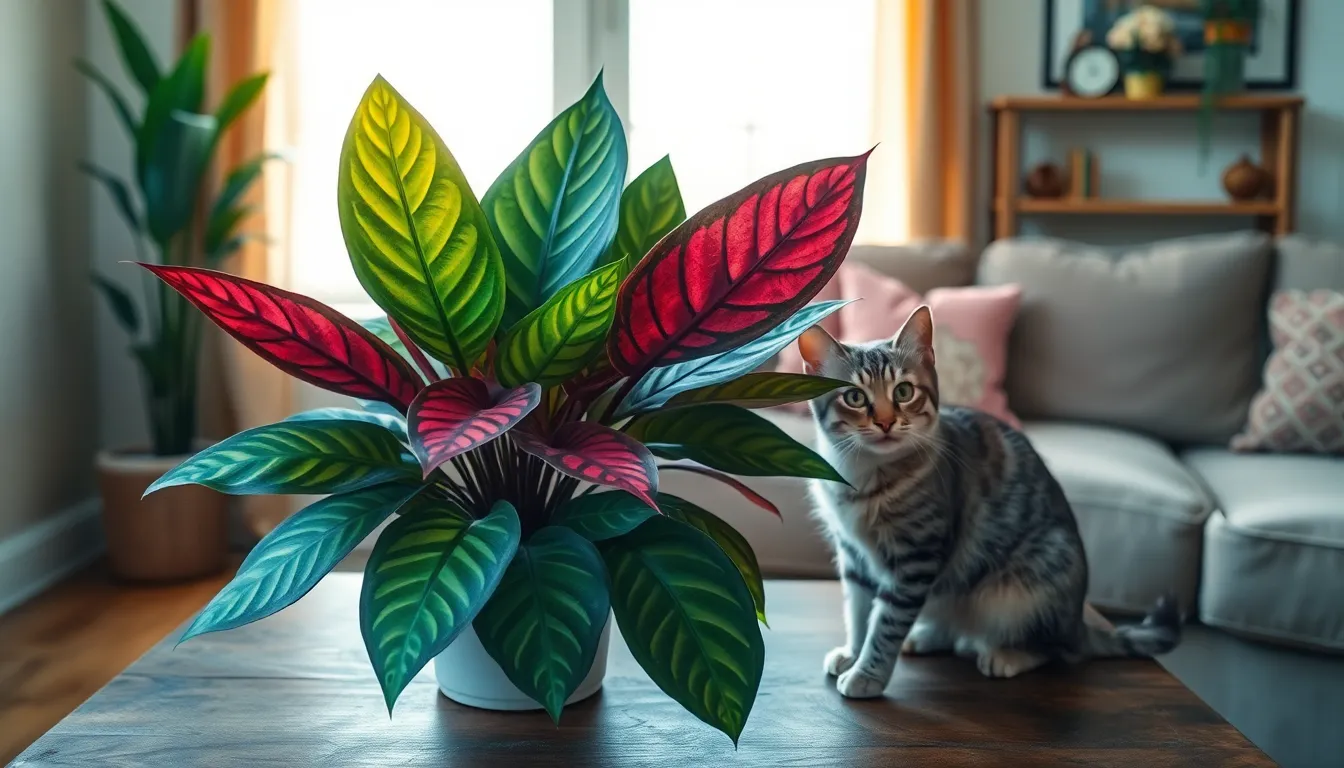
Calathea species deliver some of the most striking decorative foliage you’ll find in the houseplant industry, featuring intricate patterns and vibrant colors that make them incredibly popular among indoor gardening enthusiasts. These stunning plants offer cat owners the perfect opportunity to enjoy lush, exotic greenery without compromising their pet’s safety.
Prayer Plant Movement and Unique Characteristics
Prayer Plants (Maranta leuconeura) showcase one of nature’s most fascinating behaviors through their unique leaf movement that earned them their distinctive name. Leaves fold upward at night, creating the appearance of praying hands while displaying striking patterned foliage with red veins and beautiful shades of green throughout the day. This natural rhythm adds ever-changing visual interest to your indoor space, creating a living sculpture that changes throughout the day. Cat owners particularly appreciate this plant’s captivating characteristics, as the gentle movement often captures feline attention without posing any safety risks.
Exact Care Needs for Optimal Health
Both Calathea and Prayer Plants thrive under similar growing conditions that make them manageable additions to cat friendly homes. Indirect, filtered light prevents leaf burn while maintaining the vibrant patterns that make these plants so desirable. Consistent watering keeps soil moist without creating waterlogged conditions that can lead to root rot. High humidity levels support healthy leaf development and can be achieved through regular misting or using humidifiers in the plant’s vicinity. Cold drafts and sudden temperature changes should be avoided, with these plants preferring stable temperatures above 60°F. Well draining potting mix ensures proper root health while preventing moisture related issues that commonly affect tropical houseplants.
Pet-Safe Certification and Veterinary Approval
Calathea and Prayer Plants receive official recognition from reputable sources, including the ASPCA and Humane Society of Utah, as non-toxic options for cat owners. This certification means accidental ingestion of plant parts generally doesn’t cause toxic effects in cats, providing genuine peace of mind for pet parents. Veterinary approval and pet safe certifications ensure these plants are suitable for homes with cats, eliminating concerns about accidental poisoning or illness from curious nibbling. Cat owners can confidently display these beautiful plants throughout their homes, knowing their feline companions can explore and interact with them safely.
Bamboo Palm: Natural Air Purifier Safe for Cats
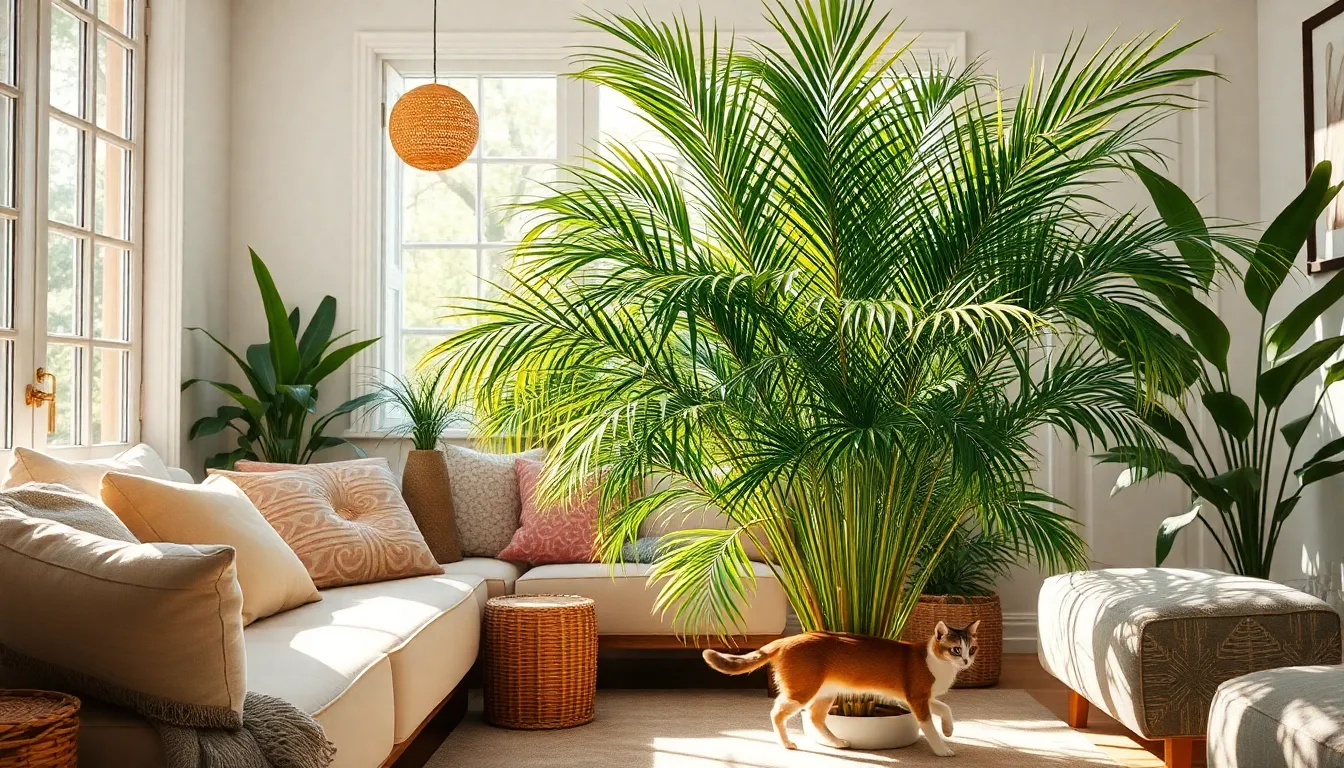
Bamboo Palm (Chamaedorea seifrizii) stands out as an exceptional choice for cat owners who want both elegant greenery and complete peace of mind. This popular indoor plant offers remarkable air purification benefits while remaining completely safe for curious felines.
Indoor Growing Conditions and Maintenance
Bamboo Palm thrives best in indirect light conditions, making it perfect for most indoor environments. We recommend maintaining consistently moist soil while allowing it to dry slightly between waterings to prevent root rot. This palm prefers warm, humid conditions similar to its natural tropical habitat.
Regular misting helps maintain the humidity levels this plant craves, especially during dry winter months. Cleaning the leaves regularly keeps them looking vibrant and tropical while ensuring optimal photosynthesis. Temperature ranges between 65-75°F create ideal growing conditions for healthy development.
Health Benefits for Both Pets and Humans
Bamboo Palm functions as a powerful natural air purifier, actively filtering harmful toxins from your indoor environment. Studies show it effectively removes formaldehyde and benzene, two common household pollutants that can affect both human and pet health. Cleaner air contributes to better respiratory health for everyone in your household.
Enhanced air quality benefits extend beyond toxin removal, as this palm helps maintain optimal humidity levels indoors. Improved air circulation and moisture balance can reduce respiratory irritation and create a healthier living environment. Both you and your cats will breathe easier with this natural air cleaning system working continuously.
Creating a Tropical Atmosphere Indoors
Bamboo Palm brings instant tropical elegance to any room with its lush, feathery fronds that create visual depth and texture. Its graceful height adds vertical interest to interior spaces while maintaining a sophisticated appearance that complements various decor styles. Unlike many toxic palms, this variety offers complete safety for curious cats who love to explore.
Decorative versatility makes Bamboo Palm suitable for corners, entryways, or as a statement piece in living areas. Its architectural form creates an airy, resort like ambiance that transforms ordinary rooms into tropical retreats. Cat owners can confidently display this beautiful palm anywhere knowing their pets can safely investigate without risk.
African Violet: Colorful Blooms Without Cat Toxicity Concerns
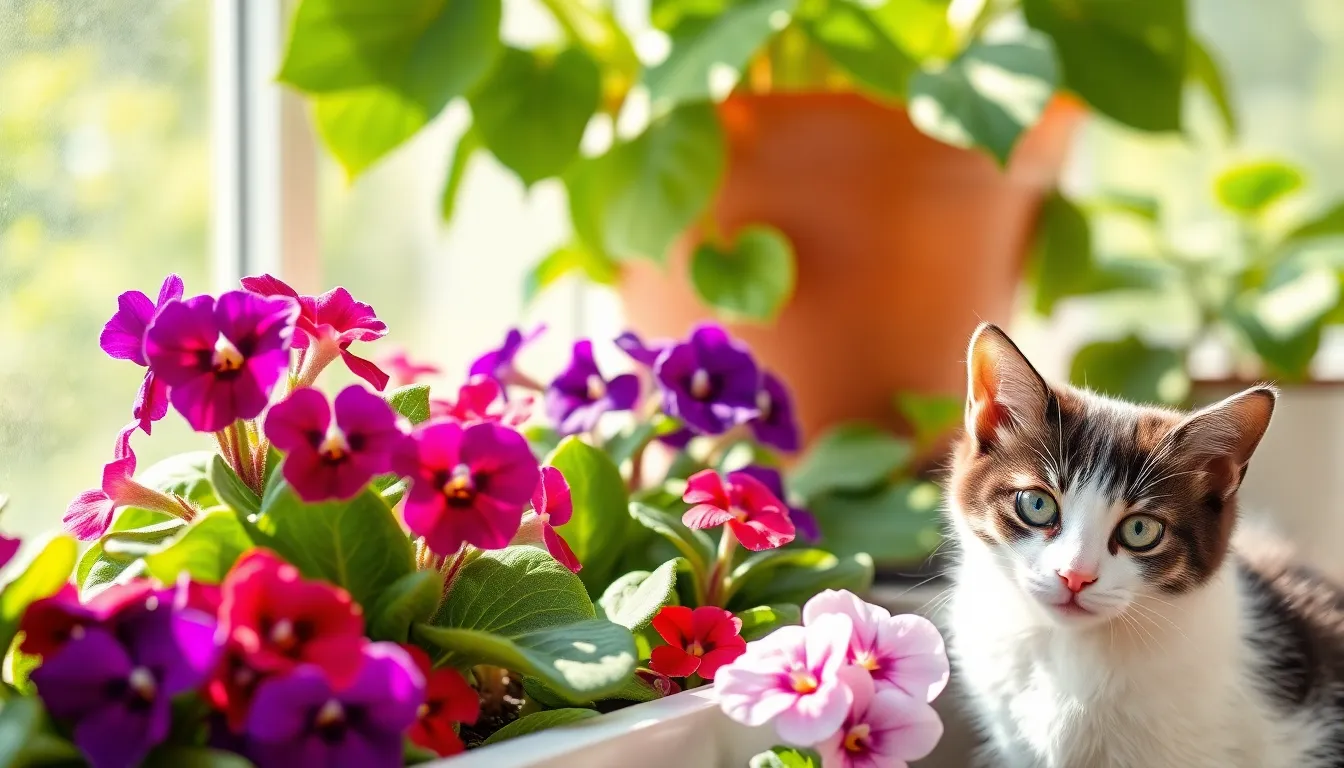
African violets bring vibrant flowering beauty to our homes while maintaining complete safety for our feline friends. These charming plants offer us the perfect solution for adding colorful blooms to our cat-safe indoor gardens.
Flowering Care and Light Requirements
African violets thrive in bright, indirect light conditions that we can easily provide in most indoor spaces. We’ll find these plants produce their most vibrant blooms when placed near east or north-facing windows where they receive gentle, filtered sunlight. Moderate watering works best for these flowering plants, and we should allow the soil to dry slightly between waterings to prevent root rot. Their low-maintenance nature makes them ideal for busy pet owners who want beautiful flowers without intensive care requirements.
Safe for Cats to Investigate and Explore
Our cats can safely investigate and explore African violets without any risk of poisoning or health complications. These plants pose no toxicity concerns if our feline companions sniff, nibble, or even chew on the leaves and colorful flowers. We don’t need to worry about keeping these plants out of reach, as African violets are completely non-toxic to cats according to veterinary sources. This safety feature allows us to place them in accessible locations where our pets can satisfy their natural curiosity without harm.
Adding Color to Cat-Friendly Plant Collections
African violets enhance our cat-safe plant collections by providing the bright, colorful blooms that many non-toxic plants lack. We can combine them with other pet-friendly options like bromeliads, money trees, and maranta plants to create diverse and visually appealing indoor gardens. Their compact size makes them perfect for displaying on shelves, windowsills, and tables alongside other safe plants. These flowering additions complement the green foliage of our other cat-safe plants, creating beautiful color contrasts that elevate our home’s aesthetic appeal while keeping our pets completely safe.
Conclusion
Creating a cat-safe indoor garden doesn’t mean sacrificing beauty or variety. We’ve shown you that many stunning plants can thrive alongside our feline friends without posing any health risks.
From the low-maintenance spider plant to the elegant Bamboo Palm each option we’ve discussed offers unique benefits while keeping our cats completely safe. Whether you’re drawn to the air-purifying qualities of Boston Ferns or the vibrant blooms of African Violets there’s something perfect for every home and skill level.
We encourage you to start small and gradually build your cat-friendly plant collection. Your indoor space will transform into a lush green sanctuary that both you and your cats can enjoy worry-free.
Frequently Asked Questions
What are the best cat-safe houseplants for beginners?
Spider plants and Boston ferns are excellent choices for beginners. Spider plants require minimal care with weekly watering and adapt to various light conditions. Boston ferns thrive in high humidity areas like bathrooms and prefer indirect light with consistent soil moisture. Both plants are completely non-toxic to cats and offer air-purifying benefits.
Are spider plants actually safe if my cat chews on them?
Yes, spider plants are completely safe for cats to chew on. In fact, many cats enjoy nibbling on the leaves because of their satisfying texture. The chewing may even aid in your cat’s digestive health. Spider plants are non-toxic and pose no poisoning risk to felines.
Which cat-safe plants work well in low-light conditions?
Parlor palms are perfect for low-light areas, thriving in low to moderate indirect light. Peperomia plants also adapt well to moderate light conditions. Both plants are completely non-toxic to cats and require minimal maintenance, making them ideal for darker rooms or offices.
How often should I water cat-safe houseplants?
Watering frequency varies by plant type. Spider plants need weekly watering, while Peperomia plants should only be watered when the top inch of soil is dry. Boston ferns prefer consistently moist soil, and Ponytail palms require infrequent watering due to their water-storing trunk.
Can cat-safe plants help purify indoor air?
Yes, several cat-safe plants offer air purification benefits. Spider plants remove formaldehyde and xylene from indoor air. Bamboo palms filter harmful toxins like formaldehyde and benzene. These plants improve air quality while being completely safe for your feline companions to explore.
What cat-safe plants add color to my home?
African violets are excellent for adding vibrant flowering color while remaining completely safe for cats. They produce colorful blooms and thrive in bright, indirect light with moderate watering. Calathea plants also offer stunning decorative foliage with intricate patterns and vibrant colors, creating visual interest without toxicity concerns.
Are there cat-safe plants suitable for small spaces?
Peperomia plants are perfect for small spaces due to their compact size. They work well on desks, shelves, and windowsills while offering diverse leaf textures and patterns. African violets are also space-efficient options that add color without taking up much room.
Which cat-safe plants require the least maintenance?
Ponytail palms are extremely low-maintenance, requiring infrequent watering due to their water-storing bulbous trunk. They thrive in bright, indirect light and well-draining soil. Spider plants are also minimal-care options, needing only weekly watering and adapting to various light conditions while being completely cat-safe.




